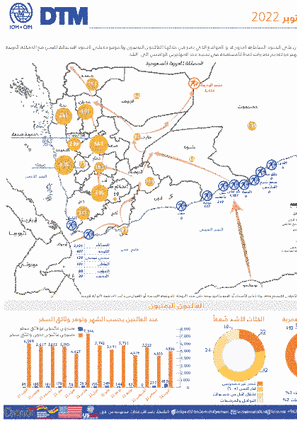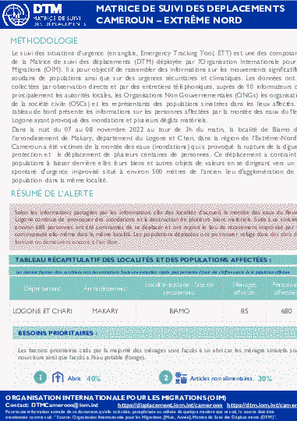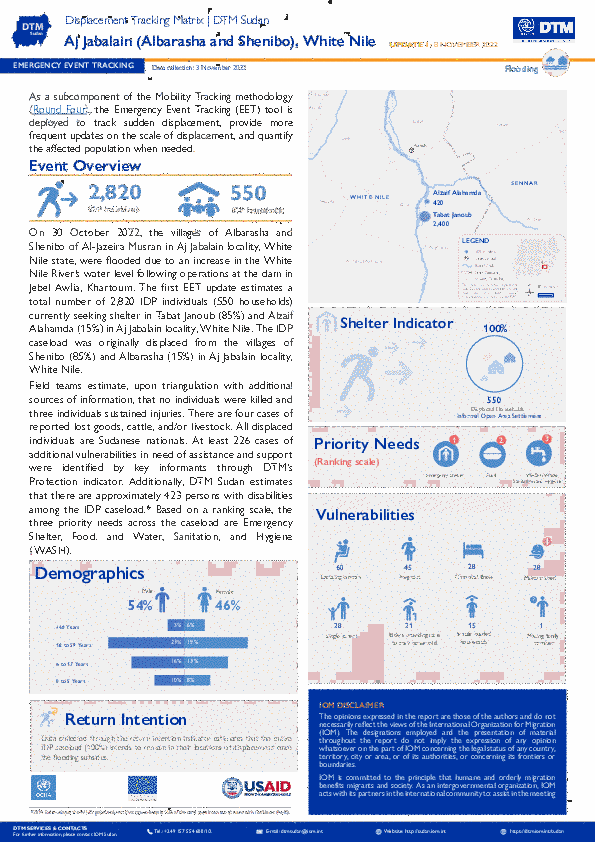-
Countries
-
Data and Analysis
-
Special Focus
-
Crisis Responses
Contact
iomyemendtm@iom.int
Location
Yemen
Activity
- Flow Monitoring
Period Covered
Oct 01 2022 -Oct 31 2022
In October 2022, IOM Yemen DTM recorded 6,381 migrants entering Yemen, an six per cent increase compared to September 2022 (6,041). In Lahj DTM has registered an increase in arrivals (+ 60%) compared to the last month in contrast to Shabwah, which registered a decrease this month (- 31%). The overall increase could be linked to weather conditions, sea tides and decreased coast guard patrolling in Djibouti. While travel had been primarily due to economic reasons in the first half of the year, DTM has been recording conflict induced movements since August, being the reason for 35 per cent of all incoming movements in October. All conflict motivated travel was recorded in Shabwah coming from Bari, Somalia (28% children, 21% women and 51% men).
Due to the deteriorating humanitarian crisis in Yemen and the challenges in moving towards KSA, many migrants opted to return to the Horn of Africa. DTM teams in Djibouti recorded that during October 2022, a total of 648 migrants took the risky return by boat from Yemen to travel home. Moreover, DTM recorded 5,454 Yemeni returns from KSA during the month of October 2022, compared to 4,532 in September 2022. Between 1 January and 31 October 2022, DTM recorded 53,401 migrants and 55,269 Yemeni migrant returnees to Yemen.
The migrant caseload was around 96 per cent Ethiopian nationals, and around four per cent Somali nationals. The migrants are predominantly male (64%), with (23%) women, seven per cent boys and six per cent girls also among the travelers.
Through September’s reporting period, 2,502 migrants arrived from Somalia and were recorded 1,957 at Ber Ali, 325 at Araqah and 218 at Eyn Bamabad flow monitoring points in Shabwah governorate. In Lahj governorate, 3,876 migrants arrived from Djibouti, where 3,101 were recorded at Al Makhabbah flow monitoring point (FMP), 407 at Al Cawhah FMP, 159 at Hasy Eisa FMP, 101 at Al-Batin FMP, 88 at Al Azaf FMP, and 20 at Al Hejaf FMP.
Population Groups
Survey Methodology
Unit of Analysis Or Observation
Type of Survey or Assessment
Keywords
Geographical Scope
Administrative boundaries with available data
The current dataset covers the following administrative boundaries

Contact
DTM Yemen, iomyemendtm@iom.int
Language
Arabic
Location
Yemen
Period Covered
Oct 01 2022
Oct 31 2022
Activity
- Flow Monitoring
في اكتوبر 2022 ، سجلت مصفوفة تتبع النزوح (DTM) التابعة للمنظمة الدولية للهجرة في اليمن 6,381 مهاجرًا دخلوا اليمن ،بزيادة قدرها (%6) مقارنة بـ 6,041 مهاجرًا في سبتمبر 2022. سجلت مصفوفة تتبع النزوح في محافظة لحج زيادة في عدد الوافدين (60+%) مقارنة بالشهر الماضي على عكس شبوة التي شهدت انخفاضاً هذا الشهر (31-%). ويمكن ربط الزيادة العام بالأحوال الجوية والمد البحري وانحفاض دوريات خفر السواحل في جيبوتي. في حين أن الهحرة كانت في المقام الأول لأسباب اقتصادية في النصف الأول من العام ، فإن مصفوفة تتبع النزوح كانت تسجل الصراع منذ أغسطس ، على انه السبب وراء 35 في المائة من جميع التحركات الواردة في أكتوبر. تم تسجيل جميع رحلات السفر بدافع الصراع في شبوة قادمة من باري ، الصومال (28٪ أطفال ، 21٪ نساء و 51٪ رجال).
بسبب الأزمة الإنسانية المتدهورة في اليمن والتحديات في المضي قدمًا نحو المملكة العربية السعودية ، اختار العديد من المهاجرين العودة إلى القرن الأفريقي. حيث سجلت فرق مصفوفة تتبع النزوح في جيبوتي خلال اكتوبر 2022 ، خوض 648 مهاجراً رحلة العودة الخطرة على متن قوارب من اليمن. بالإضافة إلى ذلك ، سجلت مصفوفة تتبع النزوح في اليمن حوالي 5,454 يمني عادوا من المملكة العربية السعودية خلال شهر اكتوبر، مقارنة بـ 4,532 في سبتمبر 2022. خلال الفترة بين 1 يناير و 31 اكتوبر 2022، وصل ما يقدر بـ 53,401 مهاجرًا و 55,269 يمنيًا عائداً إلى اليمن.
حيث مثل عدد المهاجرين من إثيوبيا96 % في المائة و اربعة في المائة من الصوماليين. كانت غالبية المهاجرين من الذكور (64) مع (23%) من النساء ، و سبعة في المائة من الأولاد وستة في المائة من الفتيات اللواتي كنا ايضاً من ضمن المسافرين.
خلال فترة التقرير في اكتوبر 2022، شوهد وصول 2,876 مهاجرا من الصومال وتم تسجيلهم في نقاط مراقبة التدفق في محافظة شبوه حيث سجل عدد 1,9587 في بئر علي و ا 325 في عرقة. بينما شهدت نقاط مراقبة التدفق بمديرية المضاربة والعارة بمحافظة لحج وصول 3,876 مهاجرا وصلوا من جيبوتي , حيث تم تسجيل 3,101 في المخابأه ؛ وا 407 في الكوحه ؛ وا 159 في حسي عيسى ؛ وا 101 في الباطن ؛ وا 88 في العزاف وا 20 في الحجيف.

Contact
DTM Yemen, iomyemendtm@iom.int
Language
English
Location
Yemen
Period Covered
Oct 01 2022
Oct 31 2022
Activity
- Flow Monitoring
In October 2022, IOM Yemen DTM recorded 6,381 migrants entering Yemen, an six per cent increase compared to September 2022 (6,041). In Lahj DTM has registered an increase in arrivals (+ 60%) compared to the last month in contrast to Shabwah, which registered a decrease this month (- 31%). The overall increase could be linked to weather conditions, sea tides and decreased coast guard patrolling in Djibouti. While travel had been primarily due to economic reasons in the first half of the year, DTM has been recording conflict induced movements since August, being the reason for 35 per cent of all incoming movements in October. All conflict motivated travel was recorded in Shabwah coming from Bari, Somalia (28% children, 21% women and 51% men).
Due to the deteriorating humanitarian crisis in Yemen and the challenges in moving towards KSA, many migrants opted to return to the Horn of Africa. DTM teams in Djibouti recorded that during October 2022, a total of 648 migrants took the risky return by boat from Yemen to travel home. Moreover, DTM recorded 5,454 Yemeni returns from KSA during the month of October 2022, compared to 4,532 in September 2022. Between 1 January and 31 October 2022, DTM recorded 53,401 migrants and 55,269 Yemeni migrant returnees to Yemen.
The migrant caseload was around 96 per cent Ethiopian nationals, and around four per cent Somali nationals. The migrants are predominantly male (64%), with (23%) women, seven per cent boys and six per cent girls also among the travelers.
Through September’s reporting period, 2,502 migrants arrived from Somalia and were recorded 1,957 at Ber Ali, 325 at Araqah and 218 at Eyn Bamabad flow monitoring points in Shabwah governorate. In Lahj governorate, 3,876 migrants arrived from Djibouti, where 3,101 were recorded at Al Makhabbah flow monitoring point (FMP), 407 at Al Cawhah FMP, 159 at Hasy Eisa FMP, 101 at Al-Batin FMP, 88 at Al Azaf FMP, and 20 at Al Hejaf FMP.

Contact
DTMAfghanistan@iom.int
Language
English
Location
Afghanistan
Period Covered
Oct 16 2022
Oct 31 2022
Activity
- Flow Monitoring
The snapshot captures present mobility and displacement trends between Afghanistan, the Islamic Republic of Iran and Pakistan.

Contact
DTM Cameroon, DTMCameroun@iom.int
Language
French
Location
Cameroon
Period Covered
Nov 07 2022
Nov 08 2022
Activity
- Mobility Tracking
- Event Tracking
Le suivi des situations d’urgence (en anglais, Emergency Tracking Tool, ETT) est une des composantes de la Matrice de suivi des déplacements (DTM) déployée par l’Organisation Internationale pour les Migrations (OIM). Il a pour objectif de rassembler des informations sur les mouvements significatifs et soudains de populations ainsi que sur des urgences sécuritaires et climatiques. Les données ont été collectées par observation directe et par des entretiens téléphoniques, auprès de 10 informateurs clés, principalement les autorités locales, les Organisations Non Gouvernementales (ONGs) les organisations de la société civile (OSCs) et les représentants des populations sinistrées dans les lieux affectés. Ce tableau de bord présente les informations sur les personnes affectées par la montée des eaux du fleuve Logone ayant provoqué des inondations et plusieurs dégâts matériels.
Dans la nuit du 07 au 08 novembre 2022 au tour de 3h du matin, la localité de Biamo dans l’arrondissement de Makary, département du Logone et Chari, dans la région de l’Extrême-Nord du Cameroun a été victimes de la montée des eaux (inondations) qui a provoqué la rupture de la digue de protection et le déplacement de plusieurs centaines de personnes. Ce déplacement a contraint les populations à laisser derrière elles leurs biens en se dirigeant vers un site spontané d'urgence improvisé situé à environ 500 mètres de l’ancien lieu d'agglomération de ces population dans la même localité.

Contact
DTM Cameroon, DTMCameroun@iom.int
Language
French
Location
Cameroon
Period Covered
Nov 07 2022
Nov 08 2022
Activity
- Mobility Tracking
- Event Tracking
Le suivi des situations d’urgence (en anglais, Emergency Tracking Tool, ETT) est une des composantes de la Matrice de suivi des déplacements (DTM) déployée par l’Organisation Internationale pour les Migrations (OIM). Il a pour objectif de rassembler des informations sur les mouvements significatifs et soudains de populations ainsi que sur des urgences sécuritaires et climatiques. Les données ont été collectées par observation directe et par des entretiens téléphoniques, auprès de 07 informateurs clés, principalement les autorités locales, les organisations non gouvernementales (ONGs), les organisations de la société civile (OSCs) et les représentants des populations sinistrées dans les lieux affectés. Ce tableau de bord présente les informations sur les personnes affectées par la montée des eaux du fleuve Logone ayant provoqué des inondations et plusieurs dégâts matériels.
Depuis le mois octobre 2022 jusqu’à nos jours, les localités situées sur les berges du fleuve Logone du côté de la République du Tchad ont été victimes de la montée des eaux (inondations) qui ont provoqué le déplacement de plusieurs centaines de personnes de la localité de Dambayel au Tchad vers la localité de Logone Birni centre (Quartier Gaoupata) dans l’arrondissement du Logone Birni, département du Logone et Chari, dans la région de l’Extrême-Nord du Cameroun.

Contact
DTM Sudan; dtmsudan@iom.int
Language
English
Location
Sudan
Snapshot Date
Nov 03 2022
Activity
- Mobility Tracking
- Event Tracking
The DTM Emergency Event Tracking (EET) is deployed to track sudden displacement and population movements, provide more frequent updates on the scale of displacement, and quantify the affected population when needed. As a subcomponent of the new Mobility Tracking methodology in Sudan (Round Four), and activated on a need basis, EET utilises a broad network of key informants to capture best estimates of the affected population presence per location – a useful tool for humanitarian response planning and design.
The Russian invasion of Ukraine has forced an unprecedented number of people to flee their homes in search of safety.
This report brings together the results of desk research and survey projects carried out by the European Union Agency for Asylum (EUAA), the International Organization for Migration (IOM) and the Organisation for Economic Co-operation and Development (OECD) to detail forced displacement from and within Ukraine. It aims at providing practitioners and policy makers with a situational picture based on the perspective of the affected populations, themselves.

Contact
DTM Djibouti, DTMDjibouti@iom.int
Language
French
Location
Djibouti
Period Covered
Sep 01 2022
Sep 30 2022
Activity
- Flow Monitoring
En septembre 2022, 18 773 mouvements ont été observés aux points de suivi des flux (FMP) à Djibouti, ce qui représente une moyenne quotidienne de 626 mouvements. Les flux migratoires ont diminué de 2% par rapport au mois d'août 2022, au cours duquel 19 163 mouvements avaient été enregistrés. Il convient de souligner qu'en septembre, les flux migratoires étaient encore inférieurs aux niveaux d'avant le COVID-19 (entre mars 2019 et mars 2020, la moyenne quotidienne
était de 654).
Sur ces 18 773 mouvements, 2 851 (15%) ont été observés dans la région d’Obock. Cette région côtière de Djibouti est la principale porte d'entrée des migrants à destination et en provenance de la péninsule arabique. Les migrants se regroupent aux points de rassemblement dans la région d'Obock d’où ils traversent ensuite le golfe d'Aden sur des bateaux le long de ce qu'on appelle la route de l'Est.
Par rapport à la période de janvier à septembre 2021, les mouvements depuis l'Éthiopie ont augmenté de 74% avec 107 394 entrées entre janvier et septembre 2022. Cependant, par rapport à août 2022, ces mouvements ont diminué de 6% en septembre 2022. Par ailleurs, une diminution de 12% peut également être observée dans les chiffres des Ethiopiens revenus du Yémen. Cette diminution peut être attribuée au renforcement des opérations de surveillance par les garde-côtes djiboutiens à Obock.

Contact
DTM Djibouti, DTMDjibouti@iom.int
Language
English
Location
Djibouti
Period Covered
Sep 01 2022
Sep 30 2022
Activity
- Flow Monitoring
In September 2022, 18,773 movements were observed at the Flow Monitoring Points (FMPs) in Djibouti, representing a daily average of 626 movements. Migration flows decreased by 2 per cent compared to August, during which 19,163 movements had been registered. It is worth highlighting that in September migration flows were still below pre-COVID19 levels (between March 2019 and March 2020, the daily average was 654).
Of these 18,773 movements, 2,851 (15%) were observed in Obock. This coastal region of Djibouti is the main gateway for migrants going to and returning from the Arabian Peninsula. Migrants regroup at gathering points in the Obock region where they then cross the Gulf of Aden on boats along the so-called Eastern route.
Compared to the period between January and September 2021, movements from Ethiopia have increased sharply by 74 per cent with 107,394 entries between January and September 2022. However, compared to August 2022, these movements decreased by 6 per cent in September 2022. Furthermore, a decrease of 12 per cent can also be observed in figures of Ethiopians who have returned from Yemen. This slight decrease may be attributed to the amplified surveillance operations by
the Djiboutian coast guards in Obock.
